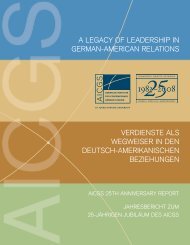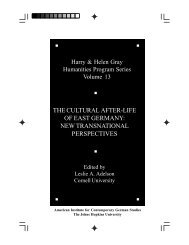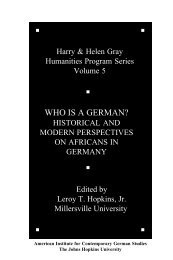the many sides of muslim integration: a german- american - aicgs
the many sides of muslim integration: a german- american - aicgs
the many sides of muslim integration: a german- american - aicgs
You also want an ePaper? Increase the reach of your titles
YUMPU automatically turns print PDFs into web optimized ePapers that Google loves.
<strong>the</strong> <strong>many</strong> <strong>sides</strong> <strong>of</strong> <strong>muslim</strong> <strong>integration</strong><br />
starts with a general comparative look at <strong>the</strong> composition<br />
<strong>of</strong> Muslim populations in Ger<strong>many</strong> and <strong>the</strong><br />
United States and considers <strong>the</strong> migration background<br />
<strong>of</strong> a majority <strong>of</strong> Muslims. Muslims’ socioeconomic<br />
situation will <strong>the</strong>n be highlighted using relevant<br />
data on different aspects <strong>of</strong> <strong>the</strong>ir economic performance<br />
from <strong>the</strong> above-mentioned studies. This <strong>the</strong>n<br />
leads to <strong>the</strong> discussion <strong>of</strong> those factors that might<br />
affect <strong>the</strong> socioeconomic <strong>integration</strong> <strong>of</strong> this selected<br />
population in both countries.<br />
The essay finally asks <strong>the</strong> question <strong>of</strong> whe<strong>the</strong>r religious<br />
beliefs are a determining factor in a social<br />
group’s economic <strong>integration</strong>. Factoring in religion<br />
may be relevant, if considerable differences between<br />
Muslims and non-Muslims with similar backgrounds in<br />
<strong>integration</strong> emerge from this analysis.<br />
Muslims in Ger<strong>many</strong> and <strong>the</strong> United<br />
States: Data and Facts<br />
SIZE OF MUSLIM POPULATION<br />
The study conducted by <strong>the</strong> Federal Office <strong>of</strong><br />
Migration and Refugees puts <strong>the</strong> generally accepted<br />
number <strong>of</strong> Muslims living in Ger<strong>many</strong> in 2009<br />
between 3.8 and 4.3 million, or 4.6 to 5.2 percent <strong>of</strong><br />
<strong>the</strong> total population. In 1987, <strong>the</strong>re were only 1.7<br />
million Muslims in Ger<strong>many</strong>, which accounted for 2.7<br />
percent <strong>of</strong> <strong>the</strong> total population. 11 In <strong>the</strong> U.S. <strong>the</strong><br />
number <strong>of</strong> Muslims is based on estimates as well.<br />
However, unlike in Ger<strong>many</strong>, <strong>the</strong>re is no widely<br />
accepted figure because different institutions,<br />
including Muslim organizations, have given varying<br />
estimates on <strong>the</strong> number <strong>of</strong> Muslims in <strong>the</strong> U.S. The<br />
more recent study by <strong>the</strong> Pew Research Center estimates<br />
<strong>the</strong> number to be as high as 2.5 million, which<br />
represents a share <strong>of</strong> approximately 0.6 percent <strong>of</strong> <strong>the</strong><br />
total population.<br />
COUNTRIES OF ORIGIN<br />
The regional origins <strong>of</strong> <strong>the</strong> Muslim population in<br />
Ger<strong>many</strong> have become much more heterogeneous in<br />
<strong>the</strong> course <strong>of</strong> <strong>the</strong> last few decades: Muslims now<br />
originate from forty-nine Islamic countries, although<br />
<strong>the</strong> dominant group is still those <strong>of</strong> Turkish descent. 12<br />
Many Muslims in Ger<strong>many</strong> still have Turkish roots but<br />
<strong>the</strong>ir proportion has become much smaller due to<br />
18<br />
increased immigration <strong>of</strong> Muslims from o<strong>the</strong>r countries.<br />
13 Thus, almost 63 percent <strong>of</strong> Muslims have<br />
Turkish roots, Sou<strong>the</strong>astern European Muslims follow<br />
with 14 percent and Muslims from <strong>the</strong> Middle East,<br />
with 8 percent. 14<br />
In <strong>the</strong> U.S. no single racial or ethnic group constitutes<br />
a majority <strong>of</strong> <strong>the</strong> more diverse Muslim population (from<br />
sixty-eight countries). A relatively large proportion <strong>of</strong><br />
Muslim immigrants comes from Arab countries (24<br />
percent), but about as <strong>many</strong> also emigrated from<br />
Pakistan and o<strong>the</strong>r Sou<strong>the</strong>ast Asian countries.<br />
Compared to o<strong>the</strong>r western countries, <strong>the</strong> ethnic<br />
composition <strong>of</strong> <strong>the</strong> Muslim population in <strong>the</strong> United<br />
States is exceptional due to <strong>the</strong> large number <strong>of</strong><br />
native-born Muslims. Thus, being Muslim in <strong>the</strong> U.S.<br />
is not automatically linked to a specific migrant group<br />
as it usually is in Ger<strong>many</strong> or in o<strong>the</strong>r European countries.<br />
MIGRATION MOTIVES<br />
In Ger<strong>many</strong>, <strong>the</strong> reasons for Muslim immigration have<br />
changed along with Muslims’ migration backgrounds<br />
and histories. The earliest notable immigration <strong>of</strong><br />
Muslims occurred in <strong>the</strong> beginning <strong>of</strong> <strong>the</strong> 1960s,<br />
when low-skilled labor migrants mainly from Turkey<br />
and North Africa arrived; 15 this group shaped <strong>the</strong><br />
socioeconomic situation <strong>of</strong> Muslims until <strong>the</strong> 1980s.<br />
In <strong>the</strong> course <strong>of</strong> <strong>the</strong> 1980s a large number <strong>of</strong> Muslim<br />
refugees and asylum seekers arrived; much <strong>of</strong> <strong>the</strong><br />
immigration history <strong>of</strong> non-Turkish Muslim immigrants<br />
is rooted in international conflict. Throughout Muslim<br />
immigration to Ger<strong>many</strong> one <strong>of</strong> <strong>the</strong> main reasons for<br />
migration has been family reunion.<br />
Today a mixed composition <strong>of</strong> Muslim migrants’ migration<br />
motives and social and economic background is<br />
evident. This leads to two socially and economically<br />
challenging conditions for a vast number <strong>of</strong> Muslim<br />
migrants in Ger<strong>many</strong>: First, unskilled workers, <strong>of</strong>ten<br />
from poor rural parts <strong>of</strong> <strong>the</strong>ir home countries, still live<br />
with <strong>the</strong>ir extended families in relatively deprived<br />
conditions. Second, refugees from war or from inhumane<br />
conditions, such as those from Afghanistan or<br />
Iraq, have limited rights and are in need <strong>of</strong> social aid.





